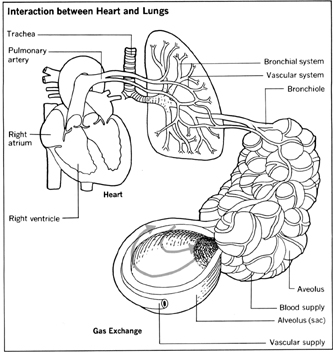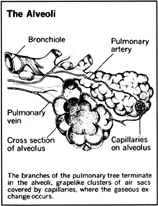The Respiratory System and the Lungs - Interaction between heart and lungs
The heart is divided vertically by a wall called a septum into right (your right) and left parts. The right part is smaller than the left: its muscles only have to pump blood a few inches to the lungs, while the muscles of the left half have to pump blood to the whole body.
The function of the right half of our heart is to receive oxygen-poor blood from the veins of the body. Venous blood empties into the top-right chamber, or right atrium, of the heart, and the right ventricle pumps that oxygen-poor blood (via the pulmonary artery) to the lungs, where the blood, passing through minute capillaries, picks up oxygen.
From the lungs, the oxygen-rich blood flows back into the heart's left atrium via the pulmonary veins; and from the left atrium, the oxygen-rich blood drains into the left ventricle, from whence it is pumped via the aorta to the body.

The blood pumped to the lungs by the right ventricle is oxygen-poor blood; it has given up its oxygen to the cells that need it around the body. But this “used blood” is rich in something else—carbon dioxide. As the body's cells have taken oxygen, they have given up carbon dioxide to the circulating blood. For both oxygen and carbon dioxide, the “carrier” has been hemoglobin , a complex iron-protein substance that is part of our red blood cells.
Capillaries and Alveoli
The pulmonary artery carrying this lung-bound blood soon branches into smaller and smaller vessels, and eventually into microscopic capillaries that reach into every crook and crevice of the lungs.
In the lungs, the walls of the capillaries touch the walls of equally microscopic structures called alveoli (singular, alveolus ). The alveoli are the smallest air sacs of the lungs. These tiny, expandable air cells are the destination of every breath of air we take. Estimates of the total number of alveoli in both our lungs vary between 300 million and a billion—in any case, we normally have several hundred million of them.
Carbon Dioxide and Oxygen Exchange
Where they meet, the membranous walls of both a capillary and an alveolus are both about as thin as any living tissue can be—a thickness that is only the width of one cell. Under such conditions, the carbon dioxide carried by the hemoglobin in our blood to the lungs diffuses (as tiny gaseous “bubbles”) across both the wall of a capillary and the wall of an alveolus.
Once inside the sac of the alveolus, carbon dioxide is ready to be exhaled from the body by “breathing out.” One indication of just how well this system works is the fact that the air we exhale has roughly 100 times more carbon dioxide than the air we breathe in.
At the same time that hemoglobin dumps carbon dioxide at the interface of the capillary and alveolus walls, it picks up the oxygen made available from inhaled fresh air that has reached the alveoli. The molecular oxygen bubbles cross the membranes in the same way—but in the opposite direction—as the carbon dioxide.
Hemoglobin in the capillaries picks up the oxygen and carries it via veins leading away from the lungs, to the left atrium of the heart.
Essential Role of Moisture
The alveolar membranes are supplied with a thin film of moisture that is absolutely indispensable to the exchange of gases in the lungs.


Comment about this article, ask questions, or add new information about this topic: